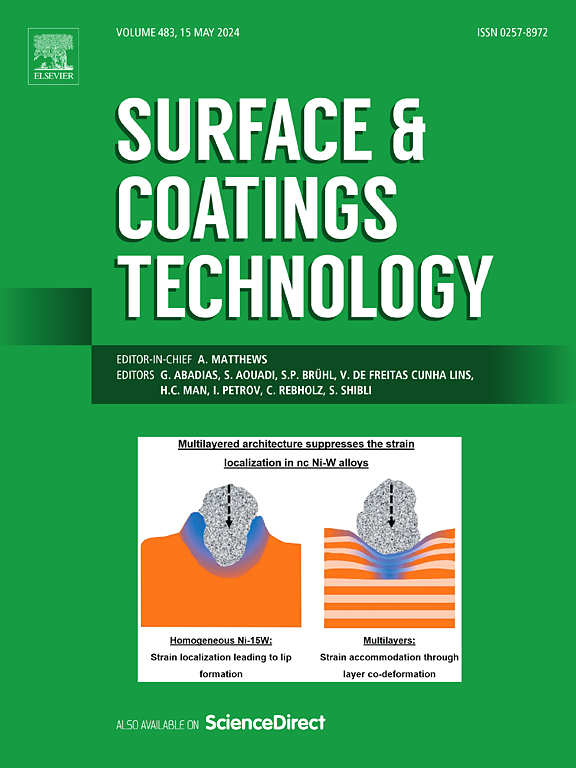引入W中间层提高TiB2薄膜的韧性和抗氧化性
IF 5.3
2区 材料科学
Q1 MATERIALS SCIENCE, COATINGS & FILMS
引用次数: 0
摘要
本研究采用dcMS-TiB2和dcMS-W在纯氩气氛下交替沉积TiB2/W纳米多层膜。W金属层的加入促进了原子扩散、界面混合和键合效应,有效抑制了富b相的偏析,减轻了TiBx在界面处的化学计量偏差。系统地研究了不同W层厚度对TiB2/W薄膜力学性能和抗氧化性能的影响。结果表明,该薄膜具有纳米多层结构,其中W中间层破坏了TiB2晶粒的柱状生长,形成了以纳米晶为主的结构,具有光滑致密的横截面特征。具有1.3 nm厚W夹层的TiB2/W薄膜的硬度为33.0±0.9 GPa,而单层TiB2薄膜的硬度为34.9±1.2 GPa。与单层TiB2薄膜相比,具有3.2 nm厚W夹层的TiB2/W薄膜的划痕韧性提高了27%,压痕韧性提高了40%,附着强度提高了57%。此外,在500°C下的氧化测试表明,TiB2/W薄膜的氧化层表面富含wo3,与氧化层厚度无关。W倾向于在TiB2/W薄膜氧化层表面形成较大的WO3颗粒。当含W夹层的TiB2/W膜厚度为>;4.9 nm时,形成的富wo3垢阻碍了氧与B的相互作用,从而显著延缓了氧化动力学。本文章由计算机程序翻译,如有差异,请以英文原文为准。
Improving toughness and oxidation resistance of TiB2 films by introducing W interlayer
This study employed alternating dcMS-TiB2 and dcMS-W in a pure argon atmosphere to deposit TiB2/W nanomultilayer films. The incorporation of the W metal interlayers facilitated atomic diffusion, interfacial mixing, and bonding effects, which effectively inhibited the segregation of B-rich phases and mitigated the stoichiometric deviation of TiBx at the interfaces. The influence of varying the W interlayer thicknesses on mechanical properties and oxidation resistance of the TiB2/W films was systematically investigated. The results revealed that the films exhibit a nanomultilayer structure, wherein the W interlayers disrupted the columnar growth of TiB2 grains, resulting in a predominantly nanocrystalline morphology with smooth and dense cross-sectional features. The TiB2/W film with 1.3-nm-thick W interlayer exhibits a hardness of 33.0 ± 0.9 GPa, while the TiB2 single-layer film is 34.9 ± 1.2 GPa. The TiB2/W film with a 3.2-nm thick W interlayer demonstrates a 27 % increase in scratch-derived toughness, a 40 % improvement in indentation-derived toughness, and a 57 % enhancement in adhesion strength compared to that of the TiB2 single-layer film. Furthermore, oxidation tests at 500 °C revealed that the surface of the oxide scales of the TiB2/W films was WO3-rich, independent of the oxide scale thickness. The W prefers to form large WO3 particles on the surface of the oxide scales of the TiB2/W films. For the thickness of TiB2/W film with W interlayers >4.9 nm, the formed WO3-rich scale blocks oxygen interaction with B, thereby significantly retarding the oxidation kinetics.
求助全文
通过发布文献求助,成功后即可免费获取论文全文。
去求助
来源期刊

Surface & Coatings Technology
工程技术-材料科学:膜
CiteScore
10.00
自引率
11.10%
发文量
921
审稿时长
19 days
期刊介绍:
Surface and Coatings Technology is an international archival journal publishing scientific papers on significant developments in surface and interface engineering to modify and improve the surface properties of materials for protection in demanding contact conditions or aggressive environments, or for enhanced functional performance. Contributions range from original scientific articles concerned with fundamental and applied aspects of research or direct applications of metallic, inorganic, organic and composite coatings, to invited reviews of current technology in specific areas. Papers submitted to this journal are expected to be in line with the following aspects in processes, and properties/performance:
A. Processes: Physical and chemical vapour deposition techniques, thermal and plasma spraying, surface modification by directed energy techniques such as ion, electron and laser beams, thermo-chemical treatment, wet chemical and electrochemical processes such as plating, sol-gel coating, anodization, plasma electrolytic oxidation, etc., but excluding painting.
B. Properties/performance: friction performance, wear resistance (e.g., abrasion, erosion, fretting, etc), corrosion and oxidation resistance, thermal protection, diffusion resistance, hydrophilicity/hydrophobicity, and properties relevant to smart materials behaviour and enhanced multifunctional performance for environmental, energy and medical applications, but excluding device aspects.
 求助内容:
求助内容: 应助结果提醒方式:
应助结果提醒方式:


